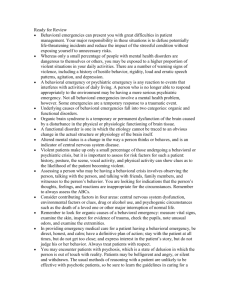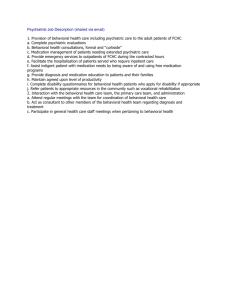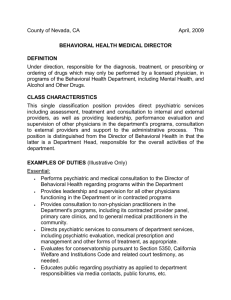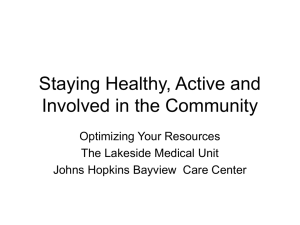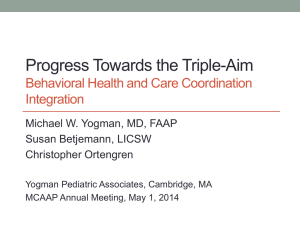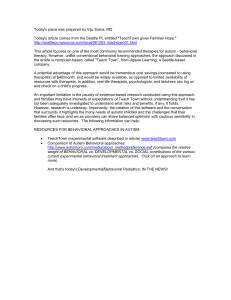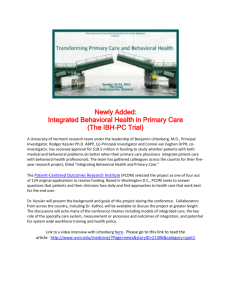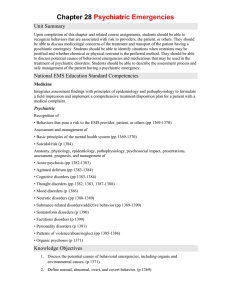Chapter 28: Psychiatric Emergencies
advertisement
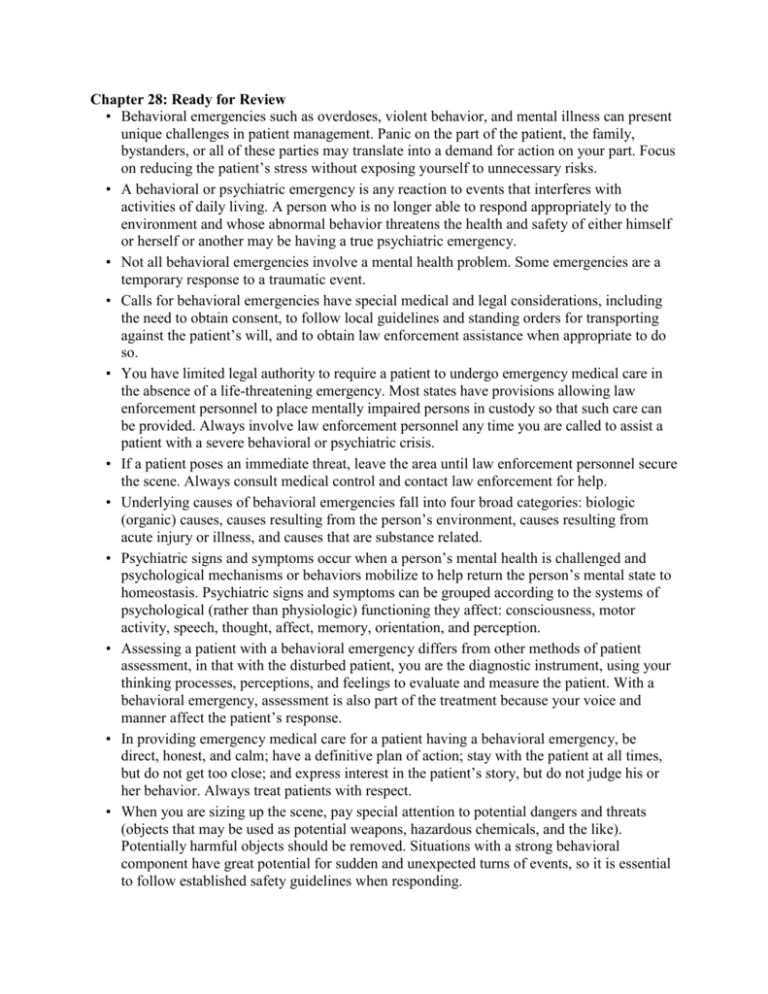
Chapter 28: Ready for Review • Behavioral emergencies such as overdoses, violent behavior, and mental illness can present unique challenges in patient management. Panic on the part of the patient, the family, bystanders, or all of these parties may translate into a demand for action on your part. Focus on reducing the patient’s stress without exposing yourself to unnecessary risks. • A behavioral or psychiatric emergency is any reaction to events that interferes with activities of daily living. A person who is no longer able to respond appropriately to the environment and whose abnormal behavior threatens the health and safety of either himself or herself or another may be having a true psychiatric emergency. • Not all behavioral emergencies involve a mental health problem. Some emergencies are a temporary response to a traumatic event. • Calls for behavioral emergencies have special medical and legal considerations, including the need to obtain consent, to follow local guidelines and standing orders for transporting against the patient’s will, and to obtain law enforcement assistance when appropriate to do so. • You have limited legal authority to require a patient to undergo emergency medical care in the absence of a life-threatening emergency. Most states have provisions allowing law enforcement personnel to place mentally impaired persons in custody so that such care can be provided. Always involve law enforcement personnel any time you are called to assist a patient with a severe behavioral or psychiatric crisis. • If a patient poses an immediate threat, leave the area until law enforcement personnel secure the scene. Always consult medical control and contact law enforcement for help. • Underlying causes of behavioral emergencies fall into four broad categories: biologic (organic) causes, causes resulting from the person’s environment, causes resulting from acute injury or illness, and causes that are substance related. • Psychiatric signs and symptoms occur when a person’s mental health is challenged and psychological mechanisms or behaviors mobilize to help return the person’s mental state to homeostasis. Psychiatric signs and symptoms can be grouped according to the systems of psychological (rather than physiologic) functioning they affect: consciousness, motor activity, speech, thought, affect, memory, orientation, and perception. • Assessing a patient with a behavioral emergency differs from other methods of patient assessment, in that with the disturbed patient, you are the diagnostic instrument, using your thinking processes, perceptions, and feelings to evaluate and measure the patient. With a behavioral emergency, assessment is also part of the treatment because your voice and manner affect the patient’s response. • In providing emergency medical care for a patient having a behavioral emergency, be direct, honest, and calm; have a definitive plan of action; stay with the patient at all times, but do not get too close; and express interest in the patient’s story, but do not judge his or her behavior. Always treat patients with respect. • When you are sizing up the scene, pay special attention to potential dangers and threats (objects that may be used as potential weapons, hazardous chemicals, and the like). Potentially harmful objects should be removed. Situations with a strong behavioral component have great potential for sudden and unexpected turns of events, so it is essential to follow established safety guidelines when responding. • Primary assessment of a behavioral emergency includes identifying yourself clearly, forming a general impression of the patient’s overall condition and the nature of the psychiatric problem, assessing the ABCs, making a decision about transport, and taking a history via the mental status examination (MSE). A useful mnemonic for the MSE is COASTMAP: consciousness, orientation, activity, speech, thought, memory, affect/mood, and perception. • Secondary assessment involves looking for signs of an organic cause of the patient’s behavioral emergency. This includes inspecting the patient for head trauma, checking pupil size, noting any unusual odors on the patient’s breath, and examining the extremities for needle tracks, tremors, or unilateral weakness/loss of sensation. • Management of the patient with a behavioral emergency is focused on ensuring scene safety and maintaining awareness of life-threatening conditions, while treating the patient for any medical disorders before assuming an emotional or psychiatric cause for the problem. • Effective communication techniques for a behavioral emergency include beginning with an open-ended question, allowing the patient to talk, showing that you are listening, allowing silence when appropriate, acknowledging and labeling the patient’s feelings, avoiding argument, facilitating communication, directing the patient’s attention, asking questions, and adjusting your approach as needed. • Crisis intervention skills include staying calm and being as direct as possible, excluding any disruptive people from the scene, sitting down to interview the patient, maintaining a nonjudgmental attitude, providing honest reassurance, developing a plan of action, encouraging some motor activity, staying with the patient at all times, bringing all of the patient’s medications to the hospital, and assuming that the patient can hear and understand everything you say. • Use of chemical or physical restraints is reserved for times when verbal intervention fails to reduce severe agitation. It is important to be familiar with the type of restraints and medications used by your agency before you encounter a situation in which they are needed. If restraints are required, use the minimum force necessary. Assess the airway, breathing, and circulation frequently while the patient is restrained, and maintain a constant dialogue with the patient throughout the restraining process. Maintain constant vigilance for safety and document everything that is done. • Pathophysiologic factors that contribute to behavioral disturbances include cognitive impairment (agitated delirium), thought disorders (including schizophrenia and psychosis), mood disorders (bipolar mood disorder, manic behavior, and depression), neurotic disorders (generalized anxiety disorder, phobias, and panic disorder), substance-related disorders and addictive behavior, somatoform disorders (hypochondriasis and conversion disorder), factitious disorders, impulse control disorders, and personality disorders. Each condition has its own unique pathophysiology as well as standards for assessment and management, so it is important to be familiar with each. • You may encounter patients with psychosis, a thought disorder characterized by a state of delusion in which the person is out of touch with reality. Patients may be belligerent and angry, or silent and withdrawn. The usual methods of reasoning with a patient are unlikely to be effective with psychotic patients, so be sure to learn the guidelines in caring for a psychotic patient, including being calm, direct, straightforward, and nonconfrontational. • You may also encounter patients with agitated delirium. This is impairment of cognitive function that can present with disorientation, hallucinations, or delusions, and is characterized by restless and irregular physical activity. One of the most important factors to consider when caring for these patients is your personal safety. Use careful interviewing techniques and refrain from upsetting the patient further. • The threat of suicide requires immediate intervention. Depression is the most significant risk factor for suicide. Other risk factors include personal or family history of suicide attempts, chronic debilitating illness, financial setback, and severe mental illness. Guidelines for managing the suicidal patient include never leaving the patient alone, collecting any implements of self-destruction, acknowledging the patient’s feelings, and providing transport. • Situations involving violence, abuse, and neglect can be a particular challenge for you because of their potential for escalation and the possibility of evoking emotional responses in you. Violent patients make up only a small percentage of those undergoing a behavioral or psychiatric crisis, but it is important for you to assess for risk factors for such a patient: history, posture, the scene, speech patterns and other vocal activity, agitation, depression, and physical activity can show clues as to the likelihood of the patient becoming violent. Management of the violent patient includes assessing the whole situation, observing your surroundings, maintaining a safe distance, and trying verbal interventions first, and of course requesting law enforcement personnel if they are not already present. • Patients with psychiatric emergencies may be taking any of several types of psychotropic drugs. During assessment, it is important to determine which medications have been prescribed for the patient and whether he or she is actually taking them. Types of psychiatric medications include antidepressants, benzodiazepines, antipsychotics, and amphetamines. The patient’s medication noncompliance often results in abnormal behaviors and confrontational behavior toward others.
